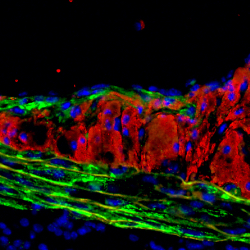
In atherogenesis, macrophages in the atherosclerotic plaque endocytose modified lipoproteins. The uptake of the modified lipoproteins results in the cytotoxic buildup of cholesterol, leading to macrophage cell death. Macrophages in the atherosclerotic plaque are also responsible for clearing apoptotic cells in a process called efferocytosis.
In early stages of atherosclerotic development, the rate of macrophage apoptosis is low and is managed through effective efferocytosis. The atherosclerotic plaque remains small and stable, and macrophage apoptosis contributes to the attenuation of plaque growth through the reduction of plaque cellularity.
In later stages, the rate of macrophage apoptosis increases and exceeds the ability of the healthy macrophages to clear the apoptotic macrophages. This change in the balance between the healthy macrophages capable of mediating efferocytosis and the dying macrophages results in defective efferocytosis and the emergence of a lipid-rich necrotic core. Over time, higher levels of apoptosis and defective efferocytosis lead to the enlargement of the necrotic core, increasing the vulnerability of the plaque to rupture. When the plaque ruptures, a thrombus is formed, and ischemia may follow.
In the Trigatti Lab, we are investigating and characterizing molecular components of pathways affecting macrophage cell death. In particular, we are examining pathways by which HDL signaling in macrophages protects them against different cell death pathways, in an effort to understand the factors that attenuate necrotic core development.
